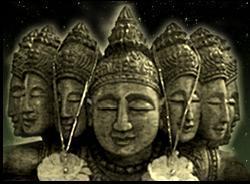About Ravana
◇ Learning about king Ravana

Emperor Ravana lived nearly 5000 years ago in Sri Lanka. He was a descendant of ‘Surya Wansha’ of ‘Hela Yakka’ tribe (ancient Sinhala tribe). King Ravana was one of the best fighters in Angampora, the traditional martial arts of ancient Sinhale.
He was a great Scholar in Ayurvedic medicine. He was the person who invented “Arka Shastra”. The book “Arka Prakshaya” reveals
this truth to the present world. As his willing to research in
Ayurvedic medicine he wrote several books revealing the cures for many
diseases. In one book he wrote “Eating beef cause to infect ninety eight new diseases to human beings”. The book “Kumara Tantraya” which reveals the treatments for infant diseases was written by him accepting the request of his pregnant queen Mandodari.
His eldest son was Indrajith also known as Meghanada who followed his
father’s steps. There are some hints in Sri Lankan rock inscriptions
about the daughter of king Dasis Ravana. King Ravana’s kingdom was
Lankapura. The kingdom is almost disappeared today. But if you keen on
Sri Lankan folklore and ola manuscripts there you can find some
remaining sites of Lankapura today known as Seegiriya and Trincomalee.
King Ravana invented the bow of Violin. He also narrated very first Raagas, the musical compositions of Eastern classical music known as Lanka Dehena. “Siva thandawa”
is one of the great devotional compositions done by him, which is still
being in use in India. He was the first king flew over the world with
his aero plane, known as Dandumonaraya, Vimaanaya or Ahasthara.
Some evidence of Dandumonaraya the aeroplane is found in Rock
inscriptions, Jataka Stories and Ola manuscripts. The Sinhalese folk
stories are enriched with Ravana Stories. King Ravana was continuing a
vegan oriented life style and was a real nature lover. According to
Lankavatara sutta he was Buddhist and worshipped Kashyapa Buddha. Once
he invited Kashyapa Buddha to visit Lanka and deliver his sermon to Sri
Lankan citizens who practice yoga and follow Buddhism.
Today the time has changed and many of us do not know the real
history of king Ravana and throw our folk tales away without considering
any valuable parts of them. King Ravana was one of the best emperors
found in Sri Lankan history. There are more than 300 Sinhala village names related to king Ravana era. In addition, there are some more places and remains in which the Rama Ravana war took place in Sri Lanka.

Brief description about emperor Rāvanā
Rāvanā was an emperor who lived about 5000 years ago in Sri Lanka. He was a descendant of ‘Surya Wansha’ of ‘Hela Yakka’ tribe (ancient Sinhala tribe). According
to Rāmāyana, the emperor Rāvanā was assassinated by Rāmā. But referring
ola manuscripts, rock inscriptions and folklore of Sri Lanka, Rāvanā
was not died at war. He was not to killed by any other common person as
Dasis Rāvanā represented a soul of a
Bodhisathva. The emperor had many names as he ruled many countries.
Rāvanā, Dasis Rāvanā, Ravula, Rāvanan, Rāvan are some of them. He is
called Dasis Rāvanā
which means the king with 10 great talents. As a well experienced
Ayurvedic physician the king wrote several books on medicine. As an
artist he composed Rāvanā rāgas.
He was an Emperor who controlled 10
states & he was the founder of civilizations like Māyā Atex in South
America, Egypt in Middle East. Archaeologists believe that, this “Hela /
Asura” civilization is the Atlantis civilization which was destroyed by
a nuclear war.
Short pre-history of Heladiva Kings

Heladiva
(Sri Lanka) dates human habitation to 125,000 years and beyond. Around
30,000 years ago it is possible that an agrarian based society
developed, supporting a self-sufficient lifestyle. This assumption is
based on the oral tradition that speaks of an ancient Hela King named
‘Manu’ who ruled the island from his capitol in Mannar (Mannarama /
‘Manu-nā-arama’) around this time.
It is said that the ‘Hela New Year’ (that dawns on April 14th each year) is in fact, the annual celebration of the coronation of this famed King Manu. [The
coronation coinciding with the Sun’s northerly movement, at a time when
it was directly over the capitol Mannar – at midday]. This legend has
now been superseded by the ‘official’ version that relies solely on the
astrological reasoning for the New Year – the transition of the Sun,
from Pisces to Aries.
After King Manu’s royal dynasty there are other royal dynasties mentioned in the oral tradition, such as Thāraka (~10,000 years ago), Mahābāli (~7500 years ago), and Rāvanā (~5000 years ago). Interestingly,
of these kings, King Rāvanā’s technological and military prowess was so
renowned that he is depicted in Indian literature as having ten heads
and numerous hands holding a multitude of weapons. When eventually King
Rāvanā succumbed, to the wrath of Rāmā, (his Indian nemesis) the people
of India rejoiced in victory and celebrated in a festival atmosphere. To
this day, the
festival of ‘Deepavali’ celebrated each year by one billion Indians
including the Tamil community, is a celebration of the defeat of this
famed Hela King Rāvanā.




No comments:
Post a Comment